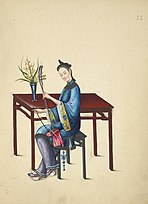List of Chinese musical instruments
Chinese musical instruments are traditionally grouped into eight categories known as bā yīn (
Silk (絲 )[edit]
Silk (
Plucked[edit]
| Name | Image |
|---|---|
| Se (Chinese: 瑟; pinyin: sè) – 25-stringed zither with movable bridges (ancient sources say 14, 25 or 50 strings)[citation needed] | 
|
| Guzheng ( |

|
| Konghou ( |

|
| Phoenix-headed konghou ( |

|
| Huluqin ( | |
| Huleiqin ( | |
| Pipa ( |

|
| Liuqin ( |

|
| Ruan (Chinese: 阮; pinyin: ruǎn) – moon-shaped lute in five sizes: gaoyin-, xiao-, zhong-, da-, and diyin-; sometimes called ruanqin (阮琴) | 
|
| Yueqin ( |
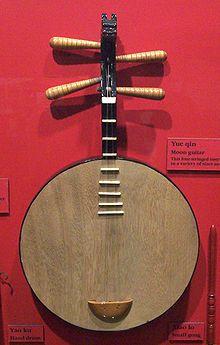
|
| Qinqin ( |

|
| Sanxian ( |

|
| Duxianqin (simplified Chinese: |
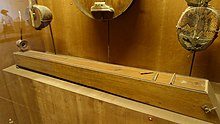
|
| Huobosi ( |

|
| Tembor (弹拨尔) – a fretted plucked long-necked lute with five strings in three courses, used in Uyghur traditional music of Xinjiang | 
|
| Dutar ( |

|
| Rawap (热瓦 |
|
| Tianqin ( | |
| Qiben ( | |
| Wanqin (弯琴) – shaped like a dragon boat. Its shape is very similar to Myanmar's saung-gauk. Another variation of the wanqin held in the form of a harp with four strings was found in a painting of Feitian in Mogao caves, Dunhuang province. | |
| Kongqin ( | |
| Dombra ( long-necked Kazakh, Uzbek and Bashkir lute and a musical string instrument |

|
| Qibue (其布 | |
| Saiding (赛玎) – The lute of Bulang people | |
| Dingbengba (玎崩 | |
| Palaung dingqin ( | |
| Sugudu (苏古笃) – a 4 trings Naxi people's lute with fretless fingerboard, and the body is traditionally made from snake skin. | |
| Kaomuzi ( |
Bowed[edit]

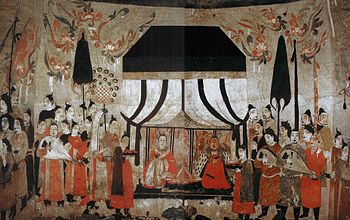
| Instrument | Image |
|---|---|
| Huqin ( |

|
| Erhu ( |

|
| Zhonghu ( |

|
| Gaohu ( |

|
| Banhu ( |

|
| Jinghu ( | |
| Jing erhu ( | |
| Erxian ( |

|
| Zhutiqin ( | |
| Yehu (椰胡) – two-stringed fiddle with coconut body, used primarily in Cantonese and Chaozhou music | 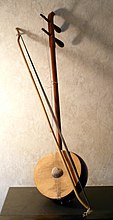
|
| Daguangxian ( | |
| Datong ( | |
| Kezaixian (壳仔 | |
| Liujiaoxian ( | |
| Tiexianzai ( | |
| Niujiaohu ( | |
| Huluhu (simplified Chinese: | |
| Maguhu (simplified Chinese: 马骨 | |
| Tuhu ( | |
| Jiaohu ( | |
| Liuhu ( | |
| Sihu ( |

|
| Sanhu ( | |
| Zhuihu (simplified Chinese: 坠胡; traditional Chinese: 墜胡) – two-stringed fiddle with fingerboard | |
| Zhuiqin (simplified Chinese: 坠琴; traditional Chinese: 墜琴) – two-stringed fiddle with fingerboard | |
| Leiqin ( | |
| Dihu ( |

|
| Xiaodihu ( | |
| Zhongdihu ( | |
| Dadihu ( | |
| Dahu ( | |
| Cizhonghu – another name for the xiaodihu | |
| Gehu ( | |
| Diyingehu ( | |
| Laruan ( |

|
| Paqin (琶琴) – bowed pear-shaped lute | |
| Dapaqin ( | |
| Niutuiqin or niubatui ( | |
| Matouqin ( |

|
| Xiqin (奚琴) – ancient prototype of huqin family of instruments | |
| Shaoqin (韶琴) – electric huqin | |
| Yazheng (simplified Chinese: 轧筝; traditional Chinese: | |
| Wenzhenqin ( | |
| Zhengni (琤尼) – bowed zither; used by the Zhuang people of Guangxi | |
| Ghaychak ( |
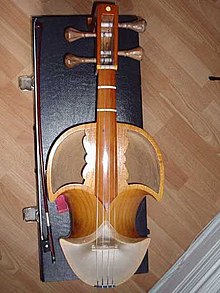
|
| Sataer (萨塔尔 or 萨它尔) – long-necked bowed lute with 13 strings used in Uyghur traditional music of Xinjiang. 1 playing string and 12 sympathetic strings. | |
| Khushtar ( |
|
| Qiaoqin (桥琴) – cello-like instrument with snakeskin resonator) from Shenyang | |
| Shenhu (桥琴) – a huqin (2-stringed vertical fiddle with snakeskin-covered resonator) with a distinctive broad, nasal timbre that is used as the primary accompanying huqin (zhu hu, |
Struck[edit]
| Instrument | Image |
|---|---|
| Yangqin ( |
|
| Zhu (筑) – a zither similar to a guzheng, played with a bamboo mallet | |
| Niujinqin ( |
Combined[edit]
- Wenqin (
文 琴 ) – a combination of the erhu, konghou, sanxian and guzheng with 50 or more steel strings. - Qingzhou cuoqin (
青 州 挫 琴 ) – strucked and bowed zither from Shandong, China.
Bamboo (竹 )[edit]

Bamboo (
Flutes[edit]
| Instrument | Image |
|---|---|
| Dizi ( |
 |
| Bangdi (梆笛) | |
| Wanguandi (弯管 | |
| Xiao (simplified Chinese: 箫; traditional Chinese: |
 |
| Paixiao (simplified Chinese: |
 |
| Chi (Chinese: 篪; pinyin: chí) – ancient transverse bamboo flute | |
| Yue (Chinese: 籥; pinyin: yuè) – ancient notched vertical bamboo flute with three finger holes; used in Confucian ritual music and dance | |
| Xindi ( | |
| Dongdi (侗笛) – wind instrument of the Dong people of southern China | |
| Koudi (Chinese: | |
| Zhuxun ( |
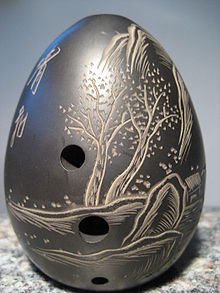 |
Free reed pipes[edit]
| Instrument | Image |
|---|---|
| Bawu (simplified Chinese: |
 |
| Mangtong (Chinese: |
Single reed pipes[edit]
| Instrument | Image |
|---|---|
| Mabu (马布) – single-reed bamboo pipe played by the Yi people |
Double reed pipes[edit]
| Instrument | Image |
|---|---|
| Guan (Chinese: |
 |
| Shuangguan ( | |
| Suona (simplified Chinese: 唢呐; traditional Chinese: 嗩吶) – double-reed wind instrument with a flaring metal bell; also called haidi ( |
 |
Wood (木 )[edit]

Most wood (
Percussion instruments[edit]
| Instrument | Image |
|---|---|
| Zhu (Chinese: 柷; pinyin: zhù) – a wooden box that tapers from the top to the bottom, played by hitting a stick on the inside, used to mark the beginning of music in ancient ritual music | |
| Yu (Chinese: 敔; pinyin: yǔ) – a wooden percussion instrument carved in the shape of a tiger with a serrated back, played by hitting a stick with an end made of approximately 15 stalks of bamboo on its head three times and across the serrated back once to mark the end of the music | |
| Muyu (simplified Chinese: | |
Paiban (
| |
Bangzi (梆子) – small, high-pitched woodblock; called qiaozi (敲子) or qiaoziban (敲子
|
Stone[edit]
The stone (
| Instrument | Image |
|---|---|
| Bianqing (simplified Chinese: 编磬; traditional Chinese: | |
| Tezhong ( |
Metal (金 )[edit]
| Instrument | Image |
|---|---|
| Bianzhong ( |
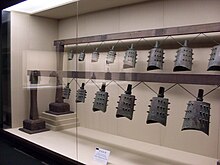 |
| Fangxiang (simplified Chinese: |
 |
| Nao (musical instrument) (鐃) – may refer to either an ancient bell or large cymbals | |
| Bo (鈸; also called chazi, 镲子) | 
|
Luo (simplified Chinese: 锣; traditional Chinese: 鑼; pinyin: luó) – gong
| |
| Yunluo (simplified Chinese: |
 |
| Shimianluo ( | |
| Qing ( | |
| Daqing ( | |
| Pengling (碰铃; pinyin: pènglíng) – a pair of small bowl-shaped finger cymbals or bells connected by a length of cord, which are struck together | |
| Dangzi (铛子) – a small, round, flat, tuned gong suspended by being tied with silk string in a round metal frame that is mounted on a thin wooden handlephoto; also called dangdang (铛铛) | |
| Yinqing (引磬) – an inverted small bell affixed to the end of a thin wooden handlephoto | |
| Yunzheng ( | |
| Chun (錞; pinyin: chún) – ancient bellphoto | |
| Tonggu (铜鼓) – bronze drum | |
| Laba ( |
Clay (土 )[edit]
| Instrument | Image |
|---|---|
| Xun (埙, Chinese: 塤; pinyin: xūn) – ocarina made of baked clay |
 |
| Fou (Chinese: |
 |
| Taodi (Chinese: |
Gourd (匏 )[edit]
| Instrument | Image |
|---|---|
| Sheng (Chinese: |
 |
| Baosheng ( | |
| Yu (Chinese: 竽; pinyin: yú) – ancient free reed mouth organ similar to the sheng but generally larger | |
| Hulusi (simplified Chinese: |
 |
| Hulusheng (simplified Chinese: | |
| Fangsheng – Northern China Gourd |
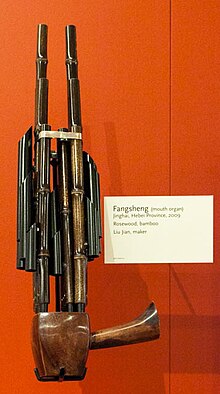 |
Hide-skin (革 )[edit]
| Instrument | Image |
|---|---|
| Dagu – ( |
 |
| Huapengu ( | |
| Huzuo Dagu ( | |
| Huzuo Wujia Gu ( | |
| Jiangu ( |
 |
| Bangu ( |
 |
| Biangu ( |
 |
| Paigu ( | |
| Tanggu ( |
 |
| Biqigu (荸荠 | |
| Diangu ( | |
| Huagu ( | |
| Yaogu ( |
 |
| Taipinggu ( | |
| Zhangu (战鼓 or |
 |
| Bajiaogu ( | |
| Yanggegu (秧歌 | |
| Gaogu (鼛鼓) – large ancient drum used to for battlefield commands and large-scale construction | |
| Bofu (搏拊) – ancient drum used to set tempo | |
| Jiegu ( | |
| Tao (鼗; pinyin: táo) or taogu (鼗鼓) – a pellet drum used in ritual music | |
| Bolang Gu ( | |
| Linggu (铃鼓) |
Others[edit]
| Instrument | Image |
|---|---|
| Gudi ( |
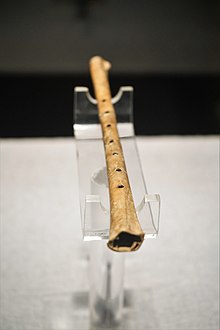 |
| Hailuo ( | |
| Kouxian ( |
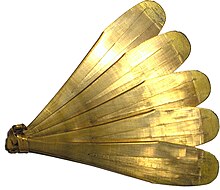 |
| Yedi ( | |
| Shuijingdi ( | |
| Zutongqin ( | |
| Shu pi hao (树皮 The instrument, which is also used by the Tujia and Miao ethnic groups of this part of Hunan province, is made by first felling a young paulownia tree, then, using a sharp knife, slowly peeling off its thin bark in a long, winding strip several inches in width. This strip of bark is then coiled tightly to produce a long conical tube that is blown from the narrow end with a buzzed embouchure, in the manner of a horn. |
Ethnic instruments[edit]
| Instrument | Image | Ethnic group |
|---|---|---|
| Frame drum |  |
Frame drums are used by ethnic groups all over China. The style of the one pictured is used mainly by Mongolic, Tungusic, and Turkic peoples. |
| Lusheng, or qeej – free reed gourd mouth organ of the Miao/Hmong people |  |
A free-reed mouth organ with five or six pipes, played by various ethnic groups in southwest China and neighboring countries, such as the Miao people (or Hmong). |
| Lilie (唎咧) – reed wind instrument with a conical bore played by the Li people of Hainan | ||
| Miaodi (Chinese: |
Flute played by the Miao |
Playing contexts[edit]
Chinese instruments are either played solo, collectively in large orchestras (as in the former imperial court) or in smaller ensembles (in teahouses or public gatherings). Normally, there is no conductor in traditional Chinese music, nor any use of musical scores or tablature in performance. Music was generally learned aurally and memorized by the musician(s) beforehand, then played without aid. As of the 20th century, musical scores have become more common, as has the use of conductors in larger orchestral-type ensembles.
Musical instruments in use in the 1800s[edit]
These watercolour illustrations, made in China in the 1800s, show several types of musical instruments being played:
-
Woman playing a dizi.
-
Woman playing a jinghu.
-
Woman playing a luo.
-
Woman playing a pipa.
-
Woman playing a sanxian.
-
Woman playing a yunluo.
-
Woman playing a xiaoluo.
-
Woman playing a haotou.
-
Woman playing a xiao.
-
Woman playing what looks like a yangqin or some sort of psaltery-like instrument.
See also[edit]
- Music of China
- Chinese culture
- Chinese art
- Chinese instrument classification
- List of ensemble formations in traditional Chinese music
- C-Rock
References[edit]
- Notes
- ^ Don Michael Randel, ed. (2003). The Harvard Dictionary of Music (4th ed.). Harvard University Press. pp. 260–262. ISBN 978-0674011632.
- ^ "
箜篌 故事 :凤首丝绸之 路上 的 凤首箜篌 " [Konghou Story: The Phoenix-headed Konghou on the Silk Road] (in Chinese). 23 August 2016.图4
柏 孜 克 里 克 第 48窟 中 的 凤首箜篌 公 元 十 世 纪 (translation: Figure 4 The phoenix-headed Konghou in Cave 48, Bezeklik, 10th century AD) - ^ "
少数 民族 拉 弦 乐器 :艾 捷 克 ". www.chinamedley.com. Archived from the original on 12 December 2006. Retrieved 11 January 2022. - ^ Patricia Ebrey (1999), Cambridge Illustrated History of China, Cambridge: Cambridge University Press, p. 148.
- ^ "photo". Archived from the original on 4 March 2009. Retrieved 8 April 2018.
- ^ Endymion Wilkinson (2000), Chinese history, ISBN 978-0-674-00249-4
- Sources
- Lee, Yuan-Yuan and Shen, Sinyan. Chinese Musical Instruments (Chinese Music Monograph Series). 1999. Chinese Music Society of North America Press. ISBN 1-880464-03-9
- Shen, Sinyan. Chinese Music in the 20th Century (Chinese Music Monograph Series). 2001. Chinese Music Society of North America Press. ISBN 1-880464-04-7
- Yuan, Bingchang, and Jizeng Mao (1986). Zhongguo Shao Shu Min Zu Yue Qi Zhi. Beijing: Xin Shi Jie Chu Ban She/Xin Hua Shu Dian Beijing Fa Xing Suo Fa Xing. ISBN 7-80005-017-3.
External links[edit]
- Chinese musical instruments
- Chinese Musical Instruments Leisure and Cultural Services Department, Hong Kong
- Chime A look at ancient Chinese instruments
- Chinese musical instruments (Chinese)
- Chinese Instruments Website Archived 2022-07-25 at the Wayback Machine (English)
- Chinese musical instruments
- The Musical Instruments E-book
- World of Instrumental Music
- The Grand Chinese New Year Concert Archived 2017-10-25 at the Wayback Machine
- Chinese Instrument
- Chinese Musical Instruments (The Modern Appearance)
- https://www.britannica.com/art/qin-musical-instrument






